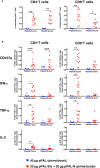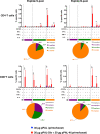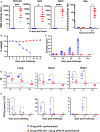Non-replicative antibiotic resistance-free DNA vaccine encoding S and N proteins induces full protection in mice against SARS-CoV-2
- PMID: 36439169
- PMCID: PMC9682132
- DOI: 10.3389/fimmu.2022.1023255
Non-replicative antibiotic resistance-free DNA vaccine encoding S and N proteins induces full protection in mice against SARS-CoV-2
Abstract
SARS-CoV-2 vaccines currently in use have contributed to controlling the COVID-19 pandemic. Notwithstanding, the high mutation rate, fundamentally in the spike glycoprotein (S), is causing the emergence of new variants. Solely utilizing this antigen is a drawback that may reduce the efficacy of these vaccines. Herein we present a DNA vaccine candidate that contains the genes encoding the S and the nucleocapsid (N) proteins implemented into the non-replicative mammalian expression plasmid vector, pPAL. This plasmid lacks antibiotic resistance genes and contains an alternative selectable marker for production. The S gene sequence was modified to avoid furin cleavage (Sfs). Potent humoral and cellular immune responses were observed in C57BL/6J mice vaccinated with pPAL-Sfs + pPAL-N following a prime/boost regimen by the intramuscular route applying in vivo electroporation. The immunogen fully protected K18-hACE2 mice against a lethal dose (105 PFU) of SARS-CoV-2. Viral replication was completely controlled in the lungs, brain, and heart of vaccinated mice. Therefore, pPAL-Sfs + pPAL-N is a promising DNA vaccine candidate for protection from COVID-19.
Keywords: DNA vaccine; N protein; S protein; SARS-CoV-2; furin; mouse model; pPAL.
Copyright © 2022 Alcolea, Larraga, Rodríguez-Martín, Alonso, Loayza, Rojas, Ruiz-García, Louloudes-Lázaro, Carlón, Sánchez-Cordón, Nogales-Altozano, Redondo, Manzano, Lozano, Palomero, Montoya, Vallet-Regí, Martín, Sevilla and Larraga.
Conflict of interest statement
The authors declare that the research was conducted in the absence of any commercial or financial relationships that could be construed as a potential conflict of interest.
Figures








References
Publication types
MeSH terms
Substances
LinkOut - more resources
Full Text Sources
Medical
Molecular Biology Databases
Miscellaneous

